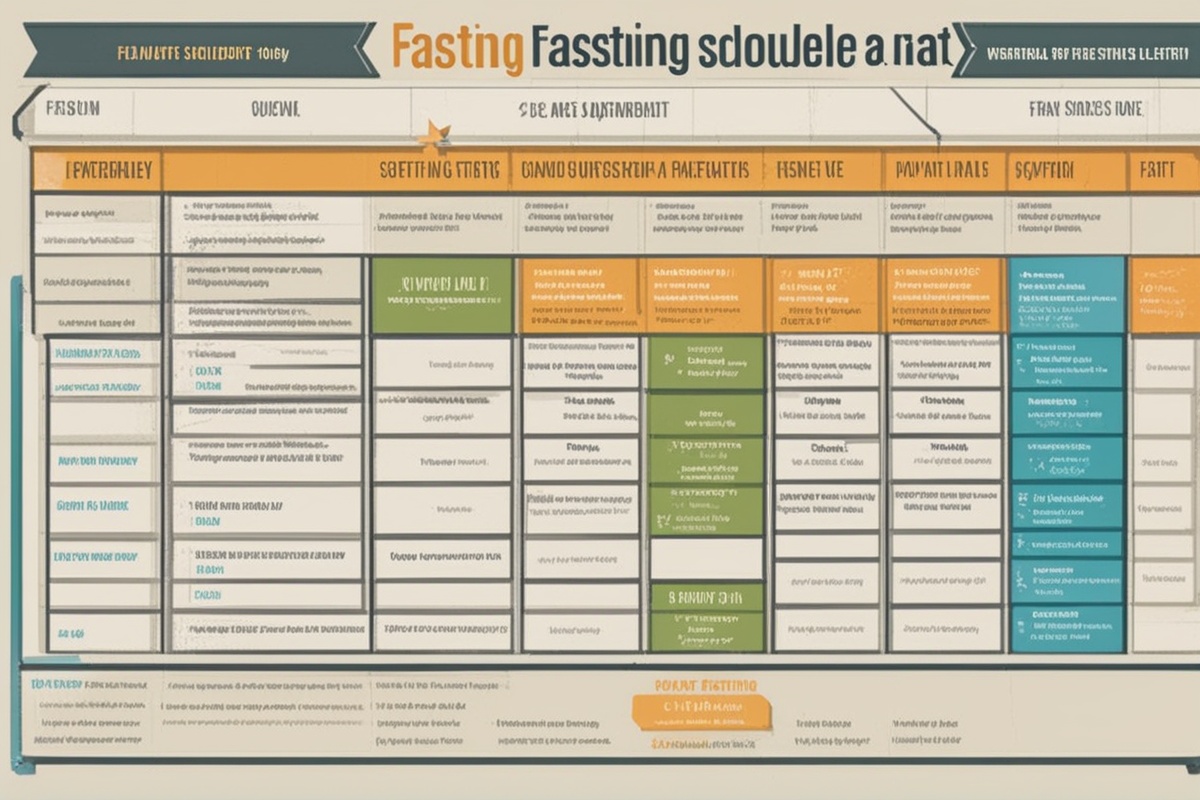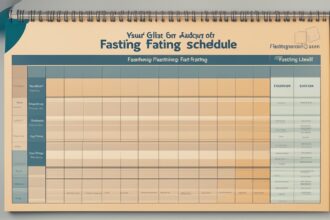Hey there, health enthusiasts! If you’ve been curious about fasting and its incredible potential to transform your wellness journey, you’re in the right place. Fasting isn’t just a passing trend; it’s a time-tested practice that’s gaining traction for its numerous health perks. From weight management to improved mental clarity, the fasting benefits are backed by science and embraced by millions worldwide. In this deep dive, we’ll explore various fasting schedules, break down how they work, and provide actionable tips to help you find the right approach for your lifestyle. Whether you’re a beginner or a seasoned faster, let’s uncover how intermittent fasting and other methods can supercharge your health!
What Are Fasting Schedules and Why Do They Matter?
Fasting schedules are structured plans that dictate when you eat and when you abstain from food. These timetables are designed to optimize the fasting benefits by aligning with your body’s natural rhythms. Unlike traditional diets that focus on what you eat, fasting emphasizes when you eat, giving your digestive system a much-needed break. Research shows that fasting can trigger processes like autophagy—your body’s way of cleaning out damaged cells—which may promote longevity and reduce inflammation (Mattson et al., 2017). Whether it’s a daily intermittent fasting routine or a longer-term fast, choosing the right schedule can make all the difference in achieving your health goals.
Popular Fasting Schedules to Maximize Fasting Benefits
With so many fasting methods out there, it can feel overwhelming to pick one. Don’t worry—I’ve got you covered with some of the most popular schedules that are known for delivering fasting benefits like improved metabolism and better blood sugar control. Let’s break them down:
- 16/8 Method: This is the go-to for beginners. You fast for 16 hours and eat during an 8-hour window (e.g., noon to 8 p.m.). It’s easy to fit into a busy lifestyle and has been linked to weight loss and better insulin sensitivity (Gabel et al., 2018).
- 5:2 Diet: Here, you eat normally for five days a week and restrict calories (about 500-600) on two non-consecutive days. It’s flexible and great for those who don’t want daily restrictions.
- Alternate-Day Fasting: As the name suggests, you alternate between fasting days (very low calories) and regular eating days. It’s more intense but can yield significant health improvements (Varady et al., 2013).
- 24-Hour Fast: Once or twice a week, you skip food for a full 24 hours. This can be a powerful reset for your system, though it’s not for everyone.
Each of these schedules taps into the health benefits of fasting, but the key is finding one that feels sustainable for you. Start small if you’re new, and listen to your body as you go.
Science Behind Fasting Benefits: What Happens to Your Body?
Ever wondered what’s happening inside your body when you fast? It’s pretty fascinating! When you abstain from food, your body shifts from using glucose (from recent meals) to stored fats for energy, a state called ketosis. This metabolic switch is one of the core fasting benefits, as it can aid in fat loss and improve metabolic health (Anton et al., 2018). Fasting also lowers insulin levels, which helps with blood sugar regulation—an important factor for preventing type 2 diabetes (Horne et al., 2015). Plus, studies suggest fasting may enhance brain function by boosting the production of brain-derived neurotrophic factor (BDNF), a protein tied to learning and memory (Mattson et al., 2017). These effects aren’t just short-term; consistent fasting may even lower the risk of chronic diseases like heart disease by improving cholesterol profiles (Tinsley & La Bounty, 2015).
That said, fasting isn’t a magic bullet. It’s most effective when paired with a balanced diet during eating windows. Think of it as a tool to enhance your overall wellness, not a cure-all.
How to Choose the Right Fasting Schedule for Your Goals
Not all fasting schedules are created equal, and your personal goals—whether it’s weight loss, mental clarity, or simply better energy—should guide your choice. If shedding pounds is your aim, the 16/8 method or 5:2 diet might be ideal, as they’ve been shown to support sustainable weight loss by reducing overall calorie intake (Gabel et al., 2018). Looking for deeper fasting benefits like cellular repair? A longer fast, such as a 24-hour or alternate-day approach, might be worth exploring since extended fasting periods enhance autophagy (Mattson et al., 2017). If you’re an athlete or highly active, shorter fasting windows can help maintain energy levels while still offering intermittent fasting advantages.
Your lifestyle matters too. If you’ve got a packed schedule or family meals to consider, forcing a rigid fasting plan might backfire. Start with something manageable, and don’t hesitate to tweak it as needed. Here are a few practical tips to help you decide:
- Assess your daily routine—can you skip breakfast easily, or do evenings work better for fasting?
- Consider your hunger cues. If you’re ravenous by midday, a shorter fasting window might be smarter.
- Consult a healthcare provider if you have medical conditions like diabetes or are pregnant—fasting isn’t for everyone (Horne et al., 2015).
- Track how you feel. Energy dips or irritability could signal the need to adjust your approach.
- Pair fasting with nutrient-dense foods during eating windows to avoid deficiencies.
Common Challenges and How to Overcome Them
Let’s be real—fasting isn’t always a walk in the park, especially when you’re starting out. Hunger pangs, cravings, and social pressures can test your resolve, but they don’t have to derail your journey to unlocking fasting benefits. One common hurdle is dealing with initial fatigue as your body adjusts to new eating patterns. Staying hydrated and getting enough rest can help ease this transition. Cravings are another beast—often, they’re more about habit than true hunger. Distract yourself with a walk or sip on black coffee or herbal tea (zero calories!) to curb the urge.
Social situations, like dinners or parties, can also throw a wrench in your fasting schedule. My advice? Plan ahead. If you know you’ve got an event, adjust your fasting window or save a low-calorie day for the 5:2 method. Remember, flexibility is key to making fasting a sustainable part of your life. And if you slip up, don’t beat yourself up—just get back on track the next day.
Maximizing Fasting Benefits with Complementary Habits
Fasting on its own can do wonders, but pairing it with healthy habits can amplify the health benefits of fasting
Don’t skimp on sleep either. Poor rest can mess with hunger hormones like ghrelin and leptin, making fasting feel harder than it needs to be. Aim for 7-9 hours a night to support your body’s recovery. Lastly, manage stress. High cortisol levels from stress can counteract some intermittent fasting advantages, so carve out time for mindfulness or meditation. Small tweaks like these can turn fasting into a holistic wellness tool.
As we’ve explored, fasting schedules offer a powerful way to tap into the fasting benefits—from weight loss and better blood sugar control to enhanced mental focus and cellular health. Whether you’re drawn to the simplicity of the 16/8 method or the intensity of a 24-hour fast, there’s a plan out there that can fit your life. The key is to start slow, stay consistent, and listen to your body. Fasting isn’t about deprivation; it’s about giving your system a chance to reset and thrive. So, why not give it a try? Pick a schedule that resonates with you, pair it with healthy habits, and watch how the health benefits of fasting unfold. Got questions or experiences to share? Drop them in the comments—I’d love to hear how fasting is working for you!
References
- Anton, S. D., Moehl, K., Donahoo, W. T., et al. (2018). Flipping the metabolic switch: Understanding and applying the health benefits of fasting. Obesity, 26(2), 254-268. https://doi.org/10.1002/oby.22065
- Gabel, K., Hoddy, K. K., Haggerty, N., et al. (2018). Effects of 8-hour time restricted feeding on body weight and metabolic disease risk factors in obese adults: A pilot study. Nutrition and Healthy Aging, 4(4), 345-353. https://doi.org/10.3233/NHA-170036
- Horne, B. D., Muhlestein, J. B., & Anderson, J. L. (2015). Health effects of intermittent fasting: Hormesis or harm? A systematic review. The American Journal of Clinical Nutrition, 102(2), 464-470. https://doi.org/10.3945/ajcn.115.109553
- Mattson, M. P., Longo, V. D., & Harvie, M. (2017). Impact of intermittent fasting on health and disease processes. Ageing Research Reviews, 39, 46-58. https://doi.org/10.1016/j.arr.2016.10.005
- Nutrition Reviews, 73(10), 661-674. https://doi.org/10.1093/nutrit/nuv041
- Varady, K. A., Bhutani, S., Klempel, M. C., et al. (2013). Alternate day fasting for weight loss in normal weight and overweight subjects: A randomized controlled trial. Nutrition Journal, 12, 146. https://doi.org/10.1186/1475-2891-12-146






